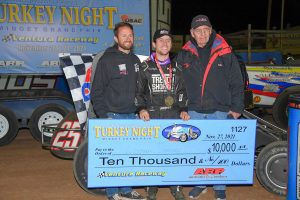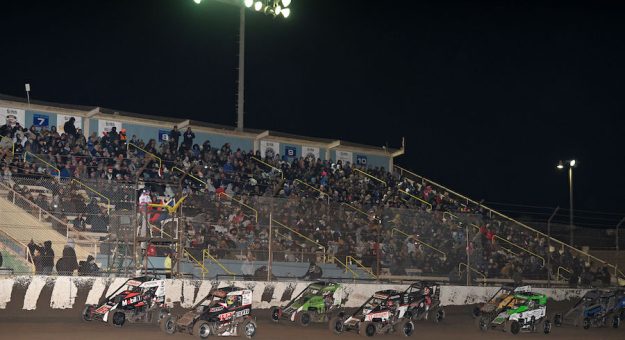Historically, midget racing has experienced as many ups and downs as the stock market. It enjoyed a brief run as one of the hottest entertainment properties in America, only to fall victim to the fickle tastes of mainstream consumers. Yet, it has survived.
Through it all, one event has reigned supreme. This year, the Turkey Night Grand Prix will be staged for the 82nd time. That alone is noteworthy. However, it can be argued that this single event changed the face of midget racing and provides a sensitive barometer of the discipline’s health.
Midget racing gained steam in 1933 and on Thanksgiving of that year Chet Mortemore took the checkered flag at Loyola Stadium in Los Angeles.
Midget racing was still a fledgling enterprise. If a solid foundation was needed to elevate the profile of the sport, the Gilmore Oil Co. was poised to provide it. In 1934, Gilmore Stadium was constructed in Los Angeles as a multi-purpose sports venue. It was a godsend for midget racing, and all agreed it was the appropriate home for a special event to be staged on Thanksgiving.
 The Turkey Night Grand Prix was born, and Bob Swanson was the inaugural winner.
The Turkey Night Grand Prix was born, and Bob Swanson was the inaugural winner.
While everyone was thrilled to have a state-of-the-art home base for midget racing, the Gilmore brass was uneasy about the quality of the product. The source of their overwhelming concern was the shocking number of engine failures. General manager Dave Koetzla had an idea. He contacted Leo Goosen, the chief engineer for Fred Offenhauser and presented his dilemma.
Goosen went to work and created the four-cylinder “Offy” midget engine. This powerplant transformed midget racing and may well have been the first salvo in an engine arms race that continues to this day.
In short order, the Turkey Night Grand Prix was the recognized crown jewel of midget racing. Then, things came to a screeching halt. In a story that never ends, nearby neighbors complained incessantly about noise and took legal action to shut the plant down. On June 7, 1950, the property was sold to CBS and the Turkey Night Grand Prix was dead.
Enter J.C. Agajanian. In the annals of auto racing, no single promoter and car owner was more influential in West Coast racing circles and arguably the entire country. Known for his signature Stetson Hat and huge smile, the self-made man decided the Turkey Night Grand Prix deserved to be resurrected.
In 1955 with Agajanian at the controls, the race returned at Gardena Stadium. Midget devotees were thrilled when 1950 Indianapolis 500 winner Johnnie Parsons took the checkered flag after 150 tough laps on the quarter-mile track. Since that time the race has been staged at multiple venues and on both dirt and pavement.
Most importantly, it has survived.
Few disagree with J. C. Agajanian Jr. who proclaims the race would have died after 1950 without the support of his father. His brother, Cary, adds important details.
“The race had been funded by the Gilmore Oil Co. and there was no one around who was willing to take the risk,” Cary Agajanian recalled. “Our dad really thought if he didn’t do it, no one would. If he had not have stepped in, you really wonder how midget racing would have gone.”
The charismatic Agajanian used his power of persuasion to attract the sport’s biggest stars. A.J. Foyt scored his first win at Indianapolis in 1961 and that same year won the Turkey Night Grand Prix for the second consecutive time. One year after he drank the milk at the Brickyard, Parnelli Jones was the best in class over 150 laps at Ascot Park.
Gary Bettenhausen would join his father, Tony, as a Turkey Night Grand Prix winner, and midget racing legend Mel Kenyon topped the field at Speedway 605 in 1975. No one was better in this historic event than Ron Shuman, who took top honors seven times including a run of four in a row.
To this day the prestige of the event draws top talent, with Billy Boat, Jason Leffler, Dave Darland, Tony Stewart and Bryan Clauson among the recent winners. Current NASCAR drivers Christopher Bell and Kyle Larson are three-time Turkey Night victors.
